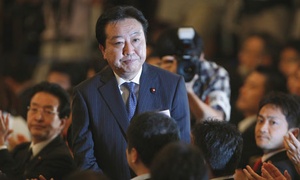
From Ukraine peace plans to Kazakh uranium—all that and more in our new nuclear digest
Our November Nuclear Digest by Bellona’s Environmental Transparency Center is out now. Here’s a quick taste of just three nuclear issues arising in U...
News

Publish date: December 19, 2011
Written by: Charles Digges
News
“Today we have reached a milestone,” said Noda in an address televised to the country, according to Japanese media. “The reactors are stable, which should resolve one big cause of concern for us all.”
The declaration, nine months after the disastrous earthquake and tsunami set off a series of failures in the nuclear power plant’s primary and back up cooling systems, leading to three core meltdowns within three days and massive releases of radiation.
Noda’s declaration could set the stage for the return of several thousand evacuees to the Fukushima prefecture in northwest Japan where the plant is located – something environmentalists familiar with the aftermath of Chernobyl and Russia’s 1957 Kyshtym disaster say is ill advised.
“It will take decades before the evacuatees can move back to their homes,” Bellona’s executive director and nuclear physicist Nils Bøhmer said.
“The Fukushima accident is far away from over, even with the reactors in cold shutdown. The hardest work is still to come, with 20 to 40 years of clean up and decommissioning work with the melted reactor cores,” he said.
Bøhmer and Igor Kudrik, a Bellona expert on the nuclear industry, have suggested that the announcement by Noda is premature. The plant remains vulnerable to aftershocks, which could knock out the jury-rigged coolant system that aided workers in bring the reactors to cold shutdown.
There also remains, said Bøhmer, the danger of the melted reactor cores re-achieving criticality – an uncontrolled chain reaction – which would lead to more radiation spreads.
Tokyo Electric Power Co, or TEPCO, has issued assurances that such fission incidents will not be self-sustaining, other scientists in Japan told the New York Times they share Bøhmer’s concern.
Kudrik did hail the cold shutdown as “good news,” but qualified that by saying that “given the state of the plant, it is difficult to have an overview of the state of the cores and thus difficult to predict future developments.”
“The disaster is certainly not over if you take into consideration the amount of resources Japan has now to invest to remediate the area around the plant and to build safe containment for the destroyed reactors” he said.
Bøhmer added that “even though the releases of radioactivity are reduced, there will still be problems with released of liquid radioactive waste, for instance.”
Irradiated liquid remains a poignant concern at Fukushima, where firemen and rescue squads had to inundate the melted down reactors with water cannons and tons of seawater dropped from helicopters.
Although the cold shutdown mode is an achievement, there are still 90,000 people that have been displaced by the disaster – which a report by Norway’s Institute for Air Research says spread as much as 40 percent of the radiation released by Chernobyl – from withing the evacuation zone around the plant alone. And even though the government is lifting evacuation restrictions for many communities, many simply don’t want to go home.
But these exhortations of safety are falling on many ears that were deafened to governmental assurances during the crisis, and which created a vacuum of trust between Tokyo and the public that will take years to heal.
“This does not ring true for us at all,” Hirofumi Onuma, a deputy high school principal in Minamisoma, a city that like many places near the plant is contaminated, but not badly enough for the government to call for its abandonment, told the New York Times.
Further afield from Fukushima, concerns about the country’s food supply remain. Radioactive cesisum, which increases cancer risks, had been detected in a wife range of products from beef to tea leave, mushroom, rich, and baby formula.
Clean up costs at the plant itself will take a heavy toll on TEPCO. The government has started to consider injecting taxpayers’ money into the utility in a bid to rescue the beleaguered company, but the company faces managerial problems that are likely to come to a head soon, said the Japan Times.
Prime Minister Noda, who came to power after his predecessor Naoto Kan resigned amid public scandal over the Fukushima disaster, has been trying to restore his country to non-crisis footing and has advocated the restarting of reactors shut down since last March.
Only eight of Japan’s 54 reactors are operating as local communities mount resistance toward restarting reactors closed for maintenance or inspection since the 9.0 quake and tsunami.
The Fukushima disaster has had ripple effects in the European nuclear industry. Germany, shortly after the disaster began, announced it would shut down its reactors by 2022. Switzerland parliament followed suit and voted its country would go non-nuclear in 2034. Italy turned out over the summer in storm to vote in a referrendum that prohibits even beginning a nuclear power program, and Beligium announced it too will go non-nuclear pending harnessing alternative energies.
And despite his enthusiasm for getting the remainder of Japan’s nuclear reactors online, Noda’s government has also pledged a 40-year phase out of nuclear power.

Our November Nuclear Digest by Bellona’s Environmental Transparency Center is out now. Here’s a quick taste of just three nuclear issues arising in U...

For three years now, Bellona has continued its work in exile from Vilnius, sustaining and expanding its analysis despite war, repression, and the collapse of international cooperation with Russia in the environmental and nuclear fields

The Board of the Bellona Foundation has appointed former Minister of Climate and the Environment Sveinung Rotevatn as Managing Director of Bellona No...

Økokrim, Norway’s authority for investigating and prosecuting economic and environmental crime, has imposed a record fine on Equinor following a comp...